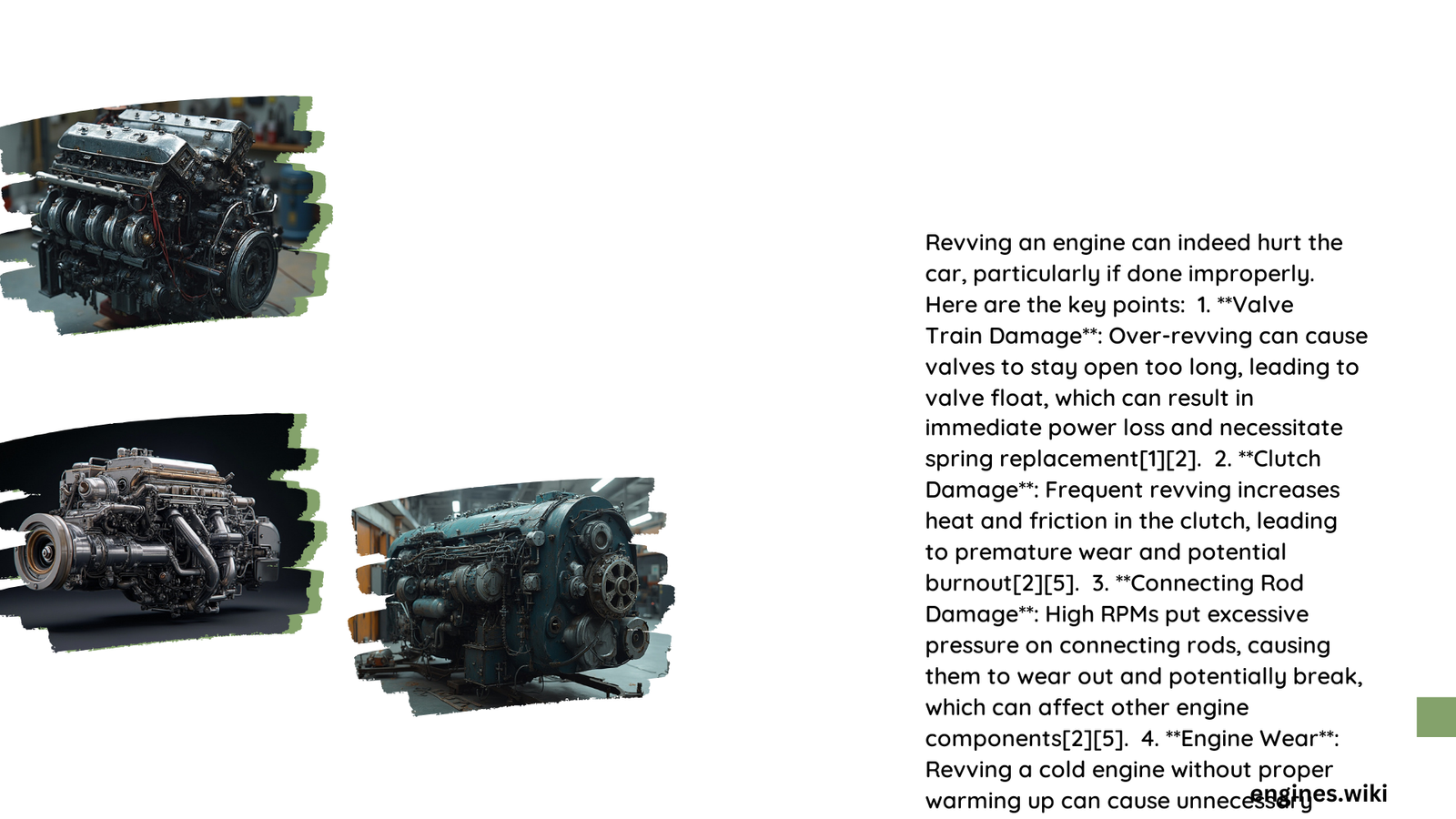Revving an engine can indeed hurt a car if done excessively or improperly. The practice of rapidly increasing engine speed, especially when the engine is cold or pushed beyond its designed limits, can lead to premature wear and potential damage to various engine components. This article explores the effects of engine revving on different parts, the role of rev limiters, and the potential costs associated with over-revving. Understanding these factors is crucial for maintaining your vehicle’s longevity and performance.
What Are the Specific RPM Limits for Various Engine Types?
Engine RPM limits vary depending on the type and design of the engine. Let’s examine the limits for two common engine types:
Naturally Aspirated Engines
Naturally aspirated engines typically have lower RPM limits compared to their turbocharged counterparts. These limits are often determined by:
- Mechanical capabilities of the engine
- Valvetrain design
- Piston speed
For example, the Subaru EJ25 engine has a rev limit of around 6250 RPM due to valve float issues. Most modern engines are limited to a piston speed of approximately 25 meters per second (or 3800 feet per minute) to prevent excessive wear and potential failure.
Turbocharged Engines
Turbocharged engines can generally operate at higher RPMs due to the turbocharger’s ability to maintain airflow at higher engine speeds. However, they still have limits based on:
- Engine design
- Component strength
- Turbocharger specifications
For instance, turbocharged engines like those in the Subaru WRX can handle higher RPMs, but they still have defined rev limits to protect the engine from damage.
How Does Excessive Revving Cause Engine Wear?

Excessive revving can lead to accelerated wear and potential damage to several engine components:
Valvetrain
- Issue: Valve float
- Cause: Insufficient valve spring stiffness at high RPMs
- Result: Reduced performance and potential engine damage
Piston and Connecting Rods
- Problem: Increased piston speed
- Effect: Accelerated wear on piston rings, cylinders, and connecting rods
- Threshold: Exceeding recommended piston speed (typically around 25 m/s)
Bearings
- Impact: Increased load and heat generation
- Consequence: Faster wear and reduced lifespan of engine bearings
What Is the Function and Effectiveness of the Rev Limiter?
Rev limiters play a crucial role in preventing engine damage from over-revving:
Engagement RPM Thresholds
- Set to prevent the engine from exceeding a specific RPM threshold
- Example: Subaru EJ25 engine rev limiter set at around 6250 RPM
Methods of Limiting RPM
- Cutting fuel supply
- Interrupting ignition
- Combination of fuel and ignition cut
Adjustability
- Can be set for soft or hard cut depending on desired engine protection level
Consequences of Rev Limiter Failure
- Potential for significant engine damage
- Risk of valve float, excessive piston speed, and bearing wear
- Can result in costly repairs or catastrophic engine failure
What Are the Quantitative Costs and Lifespan Reduction Associated with Over-Revving?
Over-revving can lead to substantial repair costs and reduced engine lifespan:
Estimated Repair Costs
| Component | Cost Range |
|---|---|
| Piston Rings | $500 – $2,000 |
| Valvetrain | $1,000 – $5,000 |
| Engine Bearings | $500 – $2,000 |
| Complete Engine Rebuild/Replacement | $5,000 – $15,000+ |
Lifespan Reduction
- Piston Rings: 20-50% reduction (e.g., from 100,000 miles to 50,000-80,000 miles)
- Valves and Valvetrain: 30-60% reduction (e.g., from 150,000 miles to 60,000-100,000 miles)
- Bearings: 20-40% reduction (e.g., from 200,000 miles to 120,000-160,000 miles)
How Can Drivers Protect Their Engines from Revving Damage?
To protect your engine from revving-related damage:
- Avoid unnecessary high RPM operation, especially when the engine is cold
- Respect the manufacturer’s recommended RPM limits
- Ensure proper maintenance of the engine, including regular oil changes
- Pay attention to warning signs such as unusual noises or vibrations
- Consider installing an aftermarket rev limiter if your vehicle doesn’t have one
What Are the Long-Term Effects of Frequent Engine Revving?
Frequent engine revving can lead to:
- Accelerated wear of engine components
- Reduced overall engine lifespan
- Increased fuel consumption
- Potential for catastrophic engine failure
- Higher maintenance and repair costs over time
By understanding the potential harm caused by excessive revving and following proper driving and maintenance practices, you can help ensure the longevity and performance of your vehicle’s engine.
References:
1. NASIOC Forums
2. RC Groups
3. Link ECU Forums
